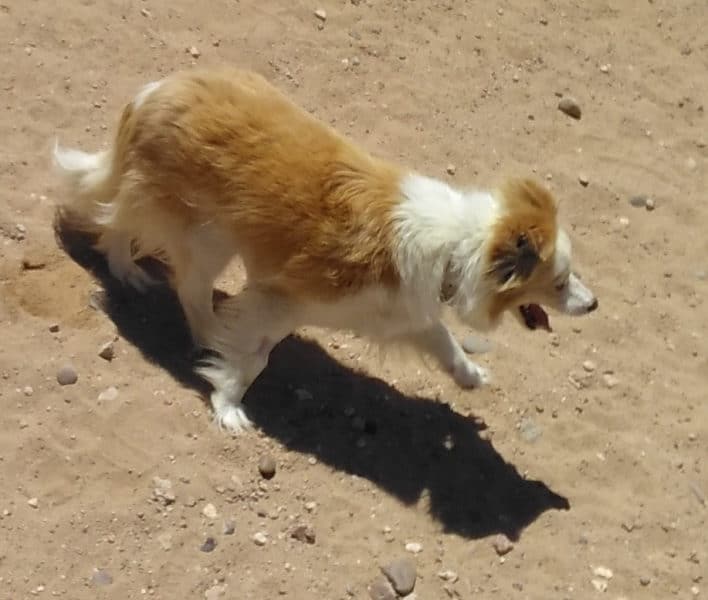Looking now at yet another gem of advice from an expert on the internet. Here we have lost animal recovery training, by Kat Albrecht. Now, with her extensive experience I’d imagine she’s found a few things which are reasonable and useful elsewhere. But this article will just focus on a single article advising people.

But, It Sounds Crazy?
We know. It sound’s crazy-stupid to say “Don’t Call Your Dog!” after your dog has escaped and is running loose (or when you encounter a stray dog).
…we need to explain that CALLING A DOG CAN CAUSE IT TO RUN FROM YOU. Your instinct, when the dog runs, is then to chase after the dog and this is the WORST thing that you can do!
Kat Albrecht
Sure, I’ve seen dogs who, when excited or nervous (or just having fun), will ignore you or just run faster. And I’ve fostered or worked with many dogs who would do that. And I’ve even seen (many) people (accidentally) train their dog for that behavior.
But that’s not all dogs, and there’s no reason at all to wait until your dog’s scared or excited to suddenly realize that you’ve forgotten to train his behavior.
What We Know (Maybe)
Here’s what we know. Some dogs that are scared off by fireworks, thunder, or other traumatic events will be so terrified that they will not even come to their owners.
Sure, there will always be some dog who will (fill_in_the_blank) when scared. But, we also know that nearly all scared dogs (and even cats) can be conditioned to follow a preset behavior which they find comforting. In some cases, the dog may wildly run over to my lap. In others, the cat races to the closet or a bush, and burrows in. They can then be taught to allow their owners to approach, although it may still take you a few minutes to calm them down.
There’s a reason why one of the worst things that you can do is call out to a stray dog or panicked dog. The reason is that it’s likely that other people (who encountered the loose dog) have already tried to capture him and calling him has become a “trigger” that causes him to automatically bolt in fear when anyone, including his owner, calls him.
My goodness! Once again we have super triggers, which can be used to rapidly train any dog to do most anything! I had one foster here who previously would break out, and could only be approached by two people she knew. Seeing either of them, however, this dog would climb mountains and leap rivers to get to them. Perhaps this has much less to do with new triggers, than if the dog had previously learned to come to his owner for security when called.
A few weeks later, Junebug came to me every time I called her, and never again tried to escape. A few months later, she was meeting new people in a kissing booth. She loved people, but had been scared of meeting new ones.

Don’t Look, Just Crawl
In many cases, people have tried to call the dog as they looked directly at the dog and walked towards it, an action that is dominate and frightening to a dog that is in the fight or flight mode.
As for looking and walking directly at the dog, this lady has no idea what the word dominate really means here. Nor does any dog simply stay in fight/flight mode for hours and days. Instead, I just slowly walk over to the side of the dog, pausing if he becomes anxious. And looking directly at a dog has no relation to an intimidating stare, and neither relates to any kind of dominance.
And here’s video of a child who used Calming Signals to calm and capture a skittish dog that adults had called (and chased off) for 2 months. The child previously had fostered this dog which was skittish, on the run, and uncatchable. Notice how the dog would not move when the child was standing, but once the child sat down and then laid on her belly (and “army crawled”), the dog calmed down and moved toward her, wagging his tail in recognition.
Oh, my! So she claims that laying on one’s belly and crawing is a calming signal? Now, we do know that dogs are very keen on human body language, and that you doing any awkward or unusual behaviors will be immediately picked up by the dog. Of course, the dog would have recognized the child right away, but the dog had been previously conditioned to calm down and approach only when she crawled on her belly. Of course, we cannot blame a child for not knowing better, but what about this trainer?

My last foster (Princess) was an 8-yr old hoarder dog who would always run away from all people. Now, I could have taught her to approach when belly-crawling, but instead taught her to love car rides. All you then needed to do was to open the car door, stand to the side, and call her. While the dog’s previous behaviors of running away from approaching people would take considerable time to change, new and different behaviors could be rapidly taught to compensate.
Triggers, we’ve got Instant Triggers!
We’ve been asked, “If I’m walking through the neighborhood searching for my dog and I can’t call his name, can I whistle?” The answer is NO, because the chances are good that if other people encountered your dog and THEY whistled to him (which many people do because, everyone knows that dogs come when you whistle, right?) then whistling also WILL BE A TRIGGER to cause your dog to run.
And she then goes on, to enumerate clapping your hands and all other things that other people might try with the dog. Then insists they will all become triggers. From another perspective, if I could produce triggers for actions that quickly and easily, just think how super fast I could train any dog to do anything at all!
What we recommend is that instead, the only sound that you make is that YOU SING TO YOUR DOG.
Singing will also help YOU to calm down and hopefully your voice will reflect PEACE rather than FEAR that comes when you’re worried and calling your dog.
Wow! Unless you commonly sing all the time, you’ll then be performing a behavior that your dog will find quite unusual. While this may calm down the person, the dog’s more likely to get confused and more excited.
Unless You’ve Never Seen this Dog Before…
If during your search you encounter your dog, do NOT call out to him and don’t use a coaxing voice.
Well, unless you just picked this dog up this morning, you should have some idea of how he’s going to react to your voice and presence. With Princess above, all I needed was to call her, then turn around and walk away. If I stood there or approached, she’d run. But if I calmly walked away, she would always follow.
Do anything other than staring straight at your dog while walking towards him!
Your body language should convey that YOU ARE EATING FOOD, DROPPING FOOD ON THE GROUND, and YOU ARE IGNORING OR HAVEN’T NOTICED THE DOG. This is the KEY to catching a loose dog
Years ago, they actually used to teach that to people at Best Friends Animal Sanctuary in Utah. It made for some fun times, as we saw people turn their heads away and trip over their own feet, scaring the heck out of the dog.
The last few loose dogs I handled by just slowly approaching to their side. Then gently signaling a greeting, while politely waiting for a response. In every case, the dog either slowly came over, or gestured for me to slowly approach. How on earth would ignoring the dog do this? And just how terrific must be your control of body language to be able to do that and fool the dog?
Crinkle, Crinkle, Pop!
Potato chip bags are PERFECT to carry your treats in because they make loud, crinkly noises that DOGS ASSOCAITE WITH FOOD.

Here we go again! Sure, if the dog already knows this. But, I’ve had many scared dogs who would be absolutely terrified by that sound.
You should also know that when dogs are in a full fight or flight mode and their adrenaline is flowing, the olfactory section of their brain closes down. That’s why sometimes when you try to feed a hotdog to a panicked dog it won’t eat it.
So sometimes the food will work, sometimes it won’t. It depends on the dog and what level of panic he is in
Goodness, is that a switch that gets flipped here? And since when is each and every skittish dog who runs away in this full fight/flight mode? She obviously hasn’t even the foggiest notion of what that really means, or she would realize that part of that phase she used is fight. Yet she gives no warning about this. And there are many scared dogs who will not approach any food with a human in sight.
So it’s far more the particular dog than the level of panic he’s in. In fact, some dogs will find food so very comforting that seeing a hot dog will override any panic.
And, the Conclusion
Many dog owners don’t believe that their own dog would not come to them and find out the hard way, even after they’ve been given this information. To be on the safe side, if you DO see your dog, instead of calling him, …
Hey, how about this instead: Start training and working with your dog, to find out just how he will behave. And, do this now, before he gets loose or just doesn’t come back home after being let out.
If he’s nervous, look for what makes him calmer, and try to make use of that. While food is both appealing and an anxiolytic, it won’t work with some. And many dogs who will always run from people in the open, can often be taught to sit next to a fence or wall, to be slowly approached. Or, as I mentioned above, to jump in a car. Keep trying ideas until you see some response, then work on that to strengthen it. It really doesn’t matter what your dog learns first, as long as it is useful in getting him if he gets loose or lost.
